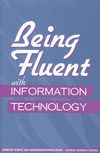
We need to have more than mere computer literacy & skills.
There is a reason we call the process of combining nursing with computer and information science, Nursing Informatics. It is imperative that all nurses develop the skills, the awareness and understanding of the utility and appropriate use of technology in both practice and personal contexts - to go beyond merely developing skills in using computers and software.
Through technology, we can express countless ideas, concepts, communications, creations, facts and information in many different ways. If these activities are done with confidence and know-how, productivity, time management and personal effectiveness can be boosted.
"As the technology changes by leaps and bounds, existing skills become antiquated and there is no migration path to new skills. A better solution is for the individual to plan to adapt to changes in the technology. This involves learning sufficient foundational material to enable one to acquire new skills independently after one's formal education is complete."
|
Although nursing involves many psychomotor tasks and activities, nurses also fit into the category of "knowledge professionals". In order to practice in the health care system of the future, nurses will need to be on par with other professionals in being able to appreciate the context and culture of using information technology in the workplace.
|
"IT literacy is being able to apply it productively at work and in everyday life." |
Information technology also makes education more accessible to nurses, since it is "an enabler for many new types of educational opportunities." An emphasis on life long learning and professional development helps put information technology in a positive light, since it is adaptable to various life situations and schedules. It is important that nurses study the logistics, the processes, any underlying hegemonies, the benefits and the pitfalls of using technology in nursing and in society in general.
Read more about becoming fluent in information technology in The National Academy of Sciences's 1999 online version of this free to read book.
back to page 1 |